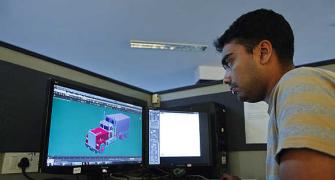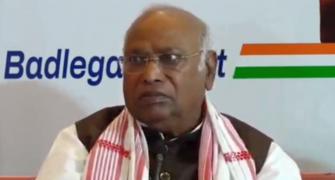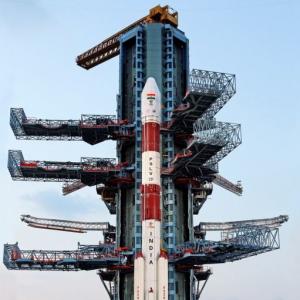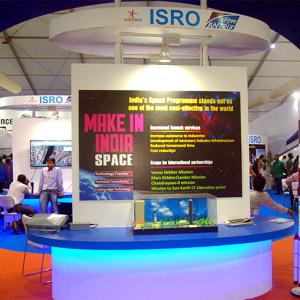'What we are trying for is to make space travel easier like air travel.'
'We have already established ourselves... the fact that other countries are coming to seek our help shows our technology is mature.'

As India successfully flight-tested the indigenous winged Reusable Launch Vehicle, Shobha Warrier/Rediff.com spoke to former Indian Space Research Organisation chairman G Madhavan Nair about how will change India’s space research.
Is it only because of the cost factor that a country's space research needs to have a Reusable Launch Vehicle? Are there any other advantages?
If you want to continue space research, you have to send instruments or people up into space, the cost of which is very high. It is roughly $20,000 per kilogramme.
Is it the vehicle that is most expensive?
Yes, 50 per cent of the cost of a launch goes into the vehicle.
After you launch a rocket, the launch vehicle falls into the sea and is lost. So, you need a new vehicle for every launch.
If you have a provision for recovering the launch vehicle, refurbishing and reusing it, naturally, the total cost will come down substantially.
You can bring down the cost from $20,000 per kg to $5,000 per kg.
Ultimately, what we are trying for is to make space travel easier like air travel. You should be able to take off from a runway, go to space and come back.
The first step towards this was taken by the Americans and they conducted some 130 launches. But the technology they use is very old, developed around 50 years ago. Also, it is not cost effective.
That is where we are seeing an opportunity to develop a unique system which should ultimately provide aircraft-like services for space travels in the future.
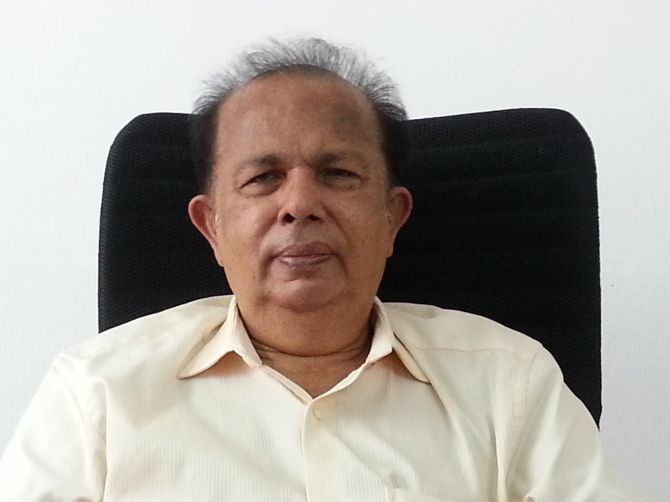 Is only the United States making reusable launch vehicles? I read that Russia and Japan are also in the process of developing such launch vehicles...
Is only the United States making reusable launch vehicles? I read that Russia and Japan are also in the process of developing such launch vehicles...
The Russians had experimented long ago and they had developed a vehicle almost like the space shuttle, but after two trials, they retired it. The Japanese also do not have such a programme; they only have some elements of the technology being demonstrated. China may have a silent programme, but we do not know.
Perhaps, we are taking a lead in this field. It is not child's play; we have to develop a lot of new technologies. That is where the real challenge lies.
ISRO's ambition is to master this technology.
When something goes into space, it achieves a velocity of nearly 7 km per second, which is 30 times the speed of an average aircraft. While returning back to earth, it enters the atmosphere with the same velocity.
To help it land safely, its velocity needs to be reduced gradually, controlling the heat (produced due to friction). It needs to be brought to a low speed like an aircraft before it could land on a runway.
The first step towards this was the demonstration that was conducted on Monday (May 23).
Though we have not achieved the required low speed, we have reached up to 1.5 km per second or so. In that speed, we demonstrated that how its speed can be further reduced and how this structure would work at very high speeds.
The highest speed which a military aircraft can attain is three times the speed of sound while, here, we have gone to six times the speed of sound. To control a big aircraft at that speed is a big challenge itself.
A lot of calculations and simulations were done and the structures were made of (reinforced) carbon-carbon and heat resistant materials like ceramic tiles. Now, we can scale it up for larger purposes.
Why is it done in different stages and not in one go?
This is because it is a totally unknown territory for Indian scientists. It is a Herculean task to convert the theory into a product. The outside temperature (during space travels) may reach up to a few thousand degree Celsius, while we have to maintain an inside temperature of less than 50 degrees C. So we have to have that type of insulating materials. That is where the ceramic tiles come into picture. But for wings, we use carbon-carbon.
We can confidently say that we have tried the first principles of design and succeeded.
How long has ISRO been working on this?
Virtually, the programme has been running for 10 years, but we could have achieved this in 5, 6 years. What happened was, during the UPA2 (United Progressive Alliance) regime, there was a policy paralysis and they were not much interested in these areas. So, it was a kind of holiday for 5 years.
Anyway, it is never too late. We have achieved something. Now that they have wetted their hands, they can think of designing the actual vehicle itself.
After the launch, you said it would take another 10 years to come out with the proper vehicle. Why another 10 years?
You have to start from the start. Say, for example, from how many passengers you want to carry to space. To define that itself will take a lot of time. Then, that definition has to match with the programme.
Right now, our launch vehicles can, at the best, take three tonnes into space, whereas the vehicle itself will weigh 10 to 15 tonnes. To take that much load will only be possible after the GSLV (GeoSynchronous Satellite Launch Vehicle) Mark 3 comes into operation, which will not happen before 2020.
By that time, we should have the design of the capsule and the life support system for that in place. Moreover, the (shuttle) speed will be increased to three times the current speed and the type of insulation required for this is different.
So, the entire design itself may take a few years. Then comes the realisation. That is why I say 10 years is a fairly optimistic time frame.
How many scientists would be needed to realise this?
Once the programme is launched, you may require at least 2,000 to 3,000 scientists.
Since no country other than the US has mastered this technology, do you see India supplying the launch vehicle to those countries that are into space research in the future?
We should be able to provide the service to others, not the vehicle.
For example, today, we are launching satellites of foreign countries using our Polar Satellite Launch Vehicle because it is cost-effective.
Similarly, we will be able to send humans or a large cargo into space much more economically and, hence, will be able to provide such services to other countries. But we will not transfer this technology to others.
It was reported that what India is doing is in direct competition with Elon Musk's SpaceX and Jeff Bezos' Blue Origin...
Today, SpaceX is the major player as the Space Shuttle (system by the National Aeronautics and Space Administration) is no longer operational. SpaceX is trying to make a new system where you can bring back the rocket to the launch pad. They even had a full-scale demonstration.
It seems the cost of SpaceX is five times more than what India would offer...
The advantage India has is the wage structure compared to the US. We pay only 1/10th the salary of US engineers. Naturally, our costs are much lower.
Is that the only reason why it is cost-effective in India?
Other than that, we normally go for an optimisation process by which we reduce the number of experiments and the number of trials.
Suppose you have to test a substance ten times before perfecting it, the cost will be high. Normally, we do 2 to 3 tests, but with heavy instrumentation, supported with analysis. The brain power of our scientists and innovative technology are also making the cost difference.
After the launch, the vehicle could not be recovered as it landed into the sea and once it touched water, it disintegrated. Was it because it was the first test that it was made to land on water to disintegrate?
It could have been landed on ground too. But at the experimental stage, if something goes wrong, it may result in loss of lives on ground. So, initially, we don't take such risks and land it on the sea. But up to the touchdown, all the data is sent to the ground station. We have full information on how the system has performed.
Using this data, we simulate the process of it coming down, touching the ground and reducing the speed. We also simulate where it is going to touch the ground, which is identified as virtual runway. The sea, of course, is not a good runway.
Can we say that once the proper vehicle is ready, the runway will not be the sea, like it was the Bay of Bengal this time?
Yes. We can launch the vehicle from here and even use the Andaman Islands as the landing site. This way, we can save energy, or otherwise, it can turn back and land at the launching site itself where we can have a runway.
Will this runway be like what you have at airports or because the speed is so high, it has to be long?
It will be almost like the usual runways, which you have for aircraft. The whole experiment is about how to reduce the speed like that of an aircraft while landing and that they have demonstrated in the first test. All the other operations are just like any other aircraft operations.
Once India develops the reusable launch vehicle, how will it change India's space research?
This is a higher order technology. We are actually marrying the rocket with the aircraft technology. We have only basic aircraft technology and have not come to an advanced state. That way, we are going to augment our basic knowledge and understanding of the aircraft system itself.
Like you said, if this technology is unique, can we say we are one of the top countries in the world in space research and technology?
We have already established ourselves (in the field of space research) as we have the indigenous cryogenic engine and stage, we have the rockets, we have the satellites, and the fact that other countries are coming here to seek our help shows our technology is mature.
Yes, now we are one step ahead of what we have done so far. In fact, India can take the leadership position if we perfect the reusable launch vehicle technology.
Of course, US companies are competing with us and they have the resources too. If we can cut the cost, we can take the lead position.
Are there private players involved in space research in the US?
Earlier, the aircraft industry started with government support, but later, private players came in and took over.
In the US, there is a trend of private players getting into space research and they have two or three established companies.
Like Space X and Blue Origin?
Yes. Virgin is also undertaking some missions. But in India, the ambience is different and in the conventional rocket making, private people are not there. But there are sub contractors in space programme. Perhaps, after sometime, here also private players may enter.
Where do you see India's space programme in the next 10 years or so?
We have been fortunate that our space programme always had a long-term vision. Just before I left office, we had a Vision 2020 Plan.
Then, due to the policy paralysis of the UPA 2, the entire plan went into a cold storage. Nothing new came in the last five years.
It is time ISRO came out with a long-term plan on what they would be doing in the next 10, 15 years. At the moment, I don't see that, but I hope ISRO will come out with such a vision plan.
I have seen ISRO grow all these years and it was only because of a long-term vision.
What we have achieved now was conceived 10 years ago. Nothing happens overnight.
When you make Vision 2020 or any such future plans, do you give importance to how it can benefit people?
Certainly. We have been doing that right from the beginning. If you look at the day-to-day life, you will understand that the absence of space technology would have affected many things adversely.
From bank transactions to stock exchanges, all depend on VSAT (very small aperture terminal) communication through satellites.
Real-time information provides a lot of inputs like where groundwater is available, where crops can be planted, etc to farmers.
Water resource management also is done with the help of satellites.
The entire entertainment industry in the country is revolutionised through satellite TV.
ISRO is the only entity that works to develop very high technology and uses it for the benefit of the people.
We have lived up to the spirit all these years.


